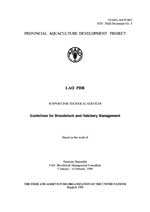
|
STS - Field Document No. 5
Guidelines for broodstock and hatchery management; Support for technical services
PROVINCIAL AQUACULTURE DEVELOPMENT PROJECT
LAO PDR
SUPPORT FOR TECHNICAL SERVICES
Based on the work of
Francois Demoulin
FAO Broodstock Management Consultant
5 January - 6 February 1999
|
|
FOOD AND AGRICULTURE ORGANIZATION OF THE UNITED NATIONS
Bangkok, 1999
|
Table of Contents
| The designations employed and the presentation of material in
this information product do not imply the expression of any
opinion whatsoever on the part of the Food and Agriculture
Organization of the United Nations concerning the legal or
development status of any country, territory, city or area or of its
authorities, or concerning the delimitation of its frontiers or
boundaries.
|
All rights reserved. Reproduction and dissemination of material in this information product for
educational or other non-commercial purposes are authorized without any prior written
permission from the copyright holders provided the source is fully acknowledged.
Reproduction of material in this information product for resale or other commercial purposes
is prohibited without written permission of the copyright holders. Applications for such
permission should be addressed to the Chief, Publishing Management Service, Information
Division, FAO, Viale delle Terme di Caracalla, 00100 Rome, Italy or by e-mail to
[email protected]
© FAO 1999
CREDITS
Figure 10 is from FAO technical paper ”The transport of live fish – A review” by R. Berka. EIFAC
Technical Paper N° 48. FAO, Rome. 1986. Drawing of Annex 4 is from FAO Manual “Simple methods for aquaculture –Management for freshwater fish culture – Ponds and water practices”, by A. Coche, J.F. Muir & T. Laughlin. FAO Training series 21/1, Rome. 1996. All other drawings are adapted from “Fish culture in Integrated Fish Farming – Part 1, General aspects, Part 2, Rearing Herbivorous fish, Part 5, Managing fish component in the farm”, by Integrated Fish Farming Project. Bank for Agriculture and Agricultural Co-operatives – Belgian
Administration for Development Co-operation. Mukdahan, Thailand. 1998. |
CONTENTS (pdf file 427Kb)
(pdf file 427Kb)
LIST OF FIGURES, TABLES AND CHARTS
INTRODUCTION
1. SOME CHARACTERISTICS OF MAIN PECIES
1.1 SIZE AT MATURITY
1.2 METHOD OF REPRODUCTION
1.3 HABITAT AND FEEDING BEHAVIOUR
1.4 TOLERANCE OF ADVERSE CONDITIONS
2. BROODSTOCK PONDS
2.1 MAIN CHARACTERISTICS
2.2 LAYOUT OF PONDS
3. STOCKING BROODSTOCK
3.1 RATE
3.2 SEPARATION OF SEXES
3.3 SEPARATION OF SPECIES
3.4 NUMBER OF SPECIES
4. MAINTAINING BROODSTOCK  (pdf file 426Kb)
(pdf file 426Kb)
4.1 KNOWING WATER CHARACTERISTICS
4.2 PREPARING THE POND
4.2.1 LIMING
4.2.2 MANURING
4.2.3 USING CHEMICAL FERTILIZERS
4.2.4 FILLING WITH WATER
4.3 FERTILIZING AND FEEDING
4.3.1 NUTRITIONAL REQUIREMENTS
4.3.2 FERTILIZATION
4.3.3 FEEDING
4.4 MAKING FEEDING EFFICIENT
4.5 TAKING CARE OF THE FISH
4.6 TAKING CARE OF THE PONDS
5. CARE DURING THE SPAWNING PHASE
5.1 BEFORE SPAWNING
5.2 SPAWNING
5.3 CARE AFTER SPAWNING
6. PREPARING FUTURE BROODSTOCK
7. TRANSPORTATION  (pdf file 579Kb)
(pdf file 579Kb)
7.1 A FEW BASICS
7.2 ON LONG DISTANCES
7.2.1 CONDITIONING
7.2.2 ANAESTHETIZING
7.2.3 TRANSPORTATION
7.2.4 RELEASE AT DESTINATION
7.2.5 BEST PERIOD FOR TRANSPORTATION
7.3 TRANSPORT AROUND THE FARM
8. PLANNING YEARLY AND MEDIUM-TERM ORGANIZATION
8.1 MARKET REQUIREMENTS
8.2 CONSTRAINTS
8.2.1 WATER AVAILABILITY
8.2.2 POND AREA
8.2.3 HATCHERY CAPACITY
8.2.4 TECHNICAL
8.2.5 MANAGERIAL / PERSONNEL
8.2.6 FINANCIAL MEANS FOR OPERATION
8.3 CASE STUDY
8.4 OPERATIONAL PLAN FOR THE YEAR
8.4.1 ACTIVITIES
8.4.2 OPERATIONAL COSTS
8.4.3 EXPECTED PRODUCTION AND INCOME
8.4.4 PROFIT AND REINVESTMENT
8.4 MEDIUM-TERM PLAN
9 ANNEXES
9.1 USE OF DERRIS ROOT FOR KILLING UNWANTED FISH IN POND
9.2 USE OF ALUM FOR CLEARING WATER
9.3 ASSOCIATION WITH LIVESTOCK FOR POND FERTILIZATION
9.4 ANAESTHETIZING BROODFISH FOR TRANSPORT
9.5 EXAMPLES OF OXYGENATION DEVICES
How to Order
